Combinatorial Proofs and Functions Assignment - CIT592
VerifiedAdded on 2022/10/17
|6
|736
|204
Homework Assignment
AI Summary
This math assignment solution covers several key concepts in discrete mathematics. It begins with an analysis of Pascal's Triangle, demonstrating Pascal's Identity and the relationship between the sums of consecutive rows. The assignment then delves into combinatorial proofs, specifically addressing a counting question related to 2-element subsets. Following this, the solution explores the concept of functions, including the determination of the number of functions between two sets and the properties of injective and surjective functions. Finally, the assignment examines the binomial theorem, explaining the coefficients and their application. The solution provides detailed proofs and explanations for each problem, including examples and conclusions to solidify understanding of the concepts.

Mathematics Assignment
Student Name:
Instructor Name:
Course Number:
21st September 2019
Student Name:
Instructor Name:
Course Number:
21st September 2019
Paraphrase This Document
Need a fresh take? Get an instant paraphrase of this document with our AI Paraphraser
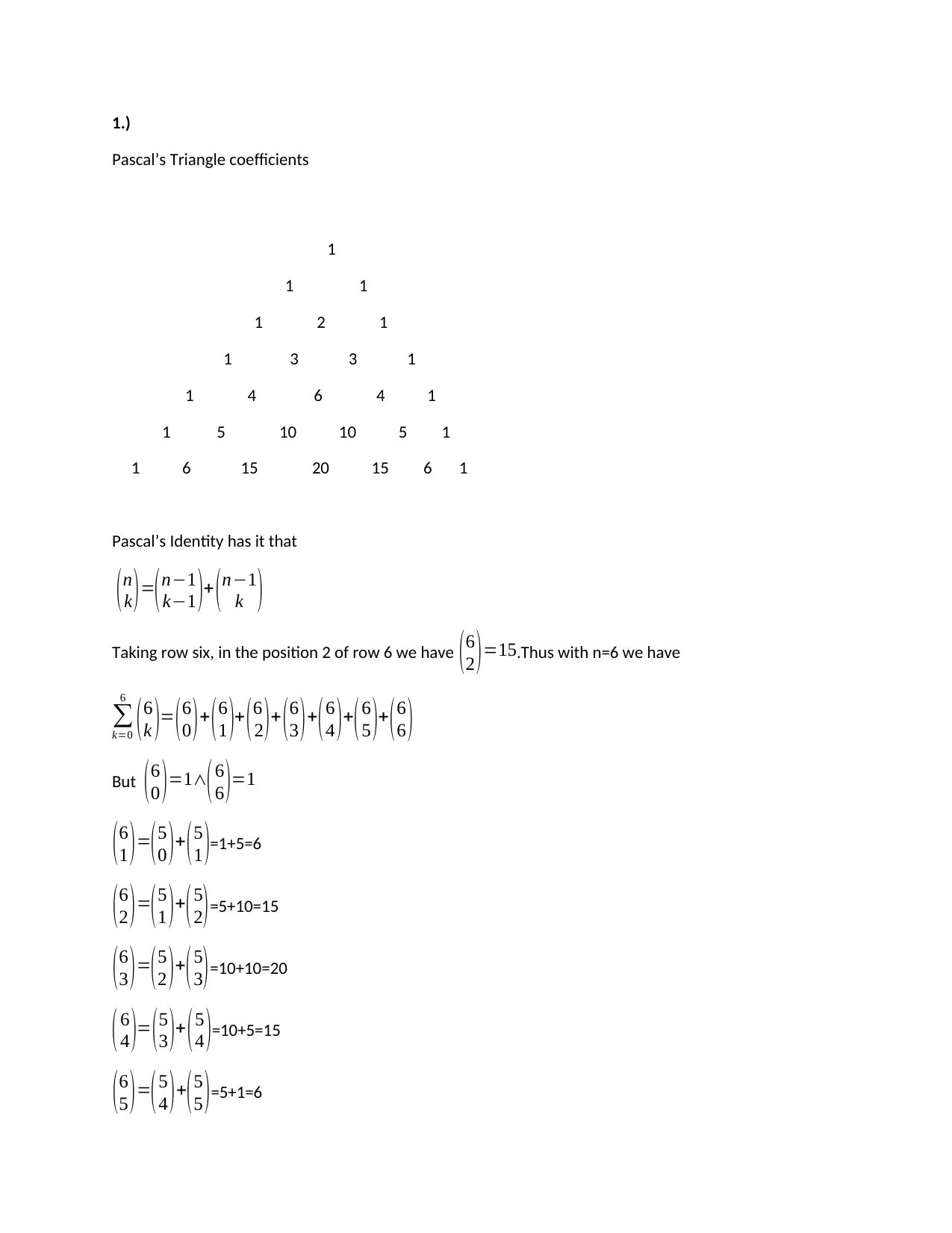
1.)
Pascal’s Triangle coefficients
1
1 1
1 2 1
1 3 3 1
1 4 6 4 1
1 5 10 10 5 1
1 6 15 20 15 6 1
Pascal’s Identity has it that
( n
k ) =( n−1
k−1 )+ ( n−1
k )
Taking row six, in the position 2 of row 6 we have ( 6
2 ) =15.Thus with n=6 we have
∑
k=0
6
(6
k )= (6
0 )+ (6
1 )+ (6
2 )+ (6
3 )+
(6
4 )+
(6
5 )+ (6
6 )
But (6
0 )=1∧(6
6 )=1
( 6
1 ) =( 5
0 ) + ( 5
1 )=1+5=6
(6
2 )=
(5
1 )+
(5
2 )=5+10=15
( 6
3 ) =
( 5
2 ) +
( 5
3 )=10+10=20
( 6
4 )= ( 5
3 )+ ( 5
4 )=10+5=15
( 6
5 ) =
( 5
4 ) +
( 5
5 )=5+1=6
Pascal’s Triangle coefficients
1
1 1
1 2 1
1 3 3 1
1 4 6 4 1
1 5 10 10 5 1
1 6 15 20 15 6 1
Pascal’s Identity has it that
( n
k ) =( n−1
k−1 )+ ( n−1
k )
Taking row six, in the position 2 of row 6 we have ( 6
2 ) =15.Thus with n=6 we have
∑
k=0
6
(6
k )= (6
0 )+ (6
1 )+ (6
2 )+ (6
3 )+
(6
4 )+
(6
5 )+ (6
6 )
But (6
0 )=1∧(6
6 )=1
( 6
1 ) =( 5
0 ) + ( 5
1 )=1+5=6
(6
2 )=
(5
1 )+
(5
2 )=5+10=15
( 6
3 ) =
( 5
2 ) +
( 5
3 )=10+10=20
( 6
4 )= ( 5
3 )+ ( 5
4 )=10+5=15
( 6
5 ) =
( 5
4 ) +
( 5
5 )=5+1=6
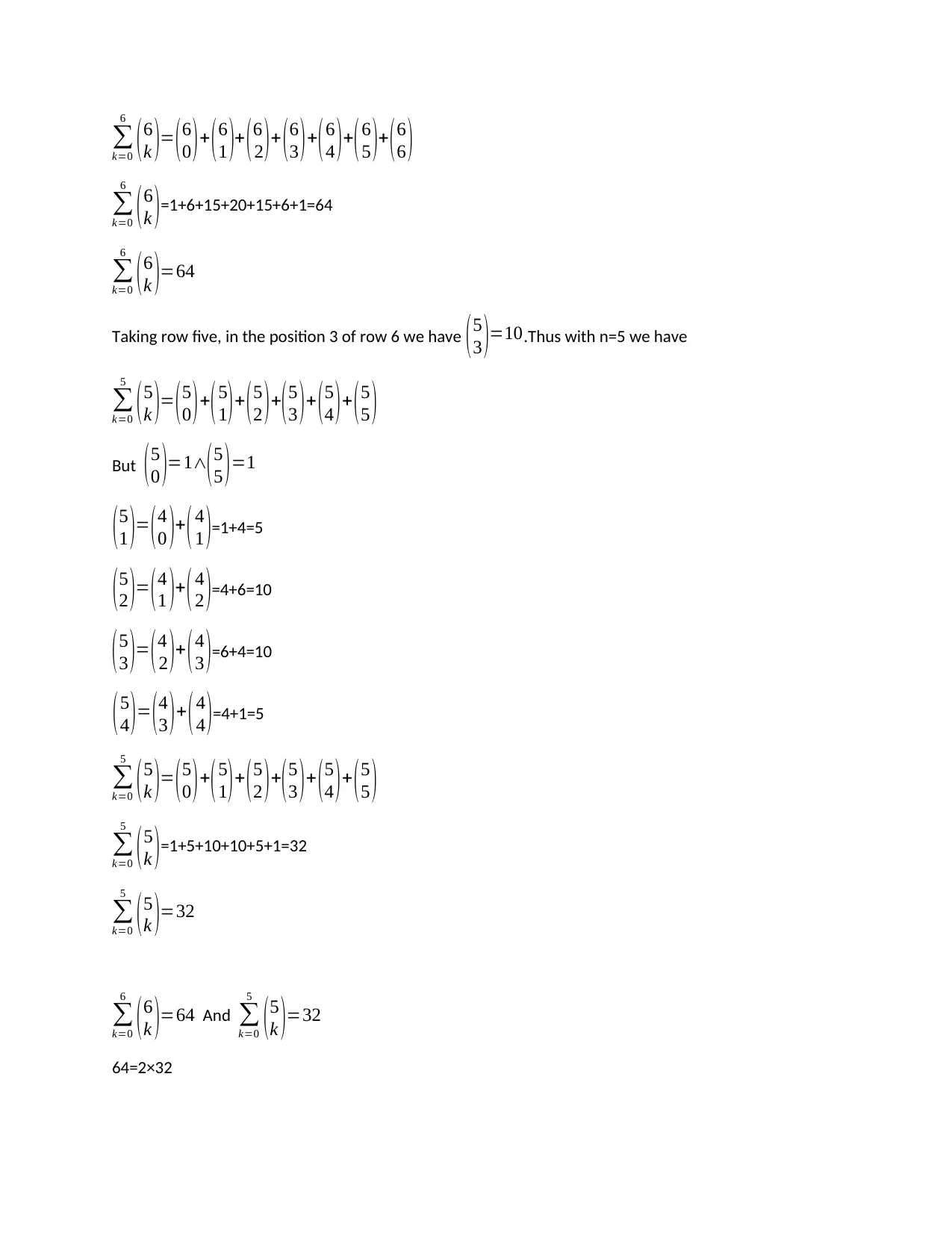
∑
k=0
6
(6
k )= (6
0 )+ (6
1 )+ (6
2 )+ (6
3 )+(6
4 )+(6
5 )+ (6
6 )
∑
k=0
6
( 6
k )=1+6+15+20+15+6+1=64
∑
k=0
6
(6
k )=64
Taking row five, in the position 3 of row 6 we have ( 5
3 )=10.Thus with n=5 we have
∑
k=0
5
( 5
k )= ( 5
0 ) +
( 5
1) + ( 5
2 ) +
( 5
3 ) + ( 5
4 ) + ( 5
5 )
But (5
0 )=1∧(5
5 )=1
( 5
1 )= ( 4
0 )+ ( 4
1 )=1+4=5
(5
2 )= (4
1 )+ (4
2 )=4+6=10
( 5
3 )= ( 4
2 )+ ( 4
3 )=6+4=10
(5
4 )= (4
3 )+ (4
4 )=4+1=5
∑
k=0
5
( 5
k )= ( 5
0 ) +
( 5
1) + ( 5
2 ) +
( 5
3 ) + ( 5
4 ) + ( 5
5 )
∑
k=0
5
( 5
k )=1+5+10+10+5+1=32
∑
k=0
5
(5
k )=32
∑
k=0
6
(6
k )=64 And ∑
k=0
5
( 5
k )=32
64=2×32
k=0
6
(6
k )= (6
0 )+ (6
1 )+ (6
2 )+ (6
3 )+(6
4 )+(6
5 )+ (6
6 )
∑
k=0
6
( 6
k )=1+6+15+20+15+6+1=64
∑
k=0
6
(6
k )=64
Taking row five, in the position 3 of row 6 we have ( 5
3 )=10.Thus with n=5 we have
∑
k=0
5
( 5
k )= ( 5
0 ) +
( 5
1) + ( 5
2 ) +
( 5
3 ) + ( 5
4 ) + ( 5
5 )
But (5
0 )=1∧(5
5 )=1
( 5
1 )= ( 4
0 )+ ( 4
1 )=1+4=5
(5
2 )= (4
1 )+ (4
2 )=4+6=10
( 5
3 )= ( 4
2 )+ ( 4
3 )=6+4=10
(5
4 )= (4
3 )+ (4
4 )=4+1=5
∑
k=0
5
( 5
k )= ( 5
0 ) +
( 5
1) + ( 5
2 ) +
( 5
3 ) + ( 5
4 ) + ( 5
5 )
∑
k=0
5
( 5
k )=1+5+10+10+5+1=32
∑
k=0
5
(5
k )=32
∑
k=0
6
(6
k )=64 And ∑
k=0
5
( 5
k )=32
64=2×32
⊘ This is a preview!⊘
Do you want full access?
Subscribe today to unlock all pages.

Trusted by 1+ million students worldwide
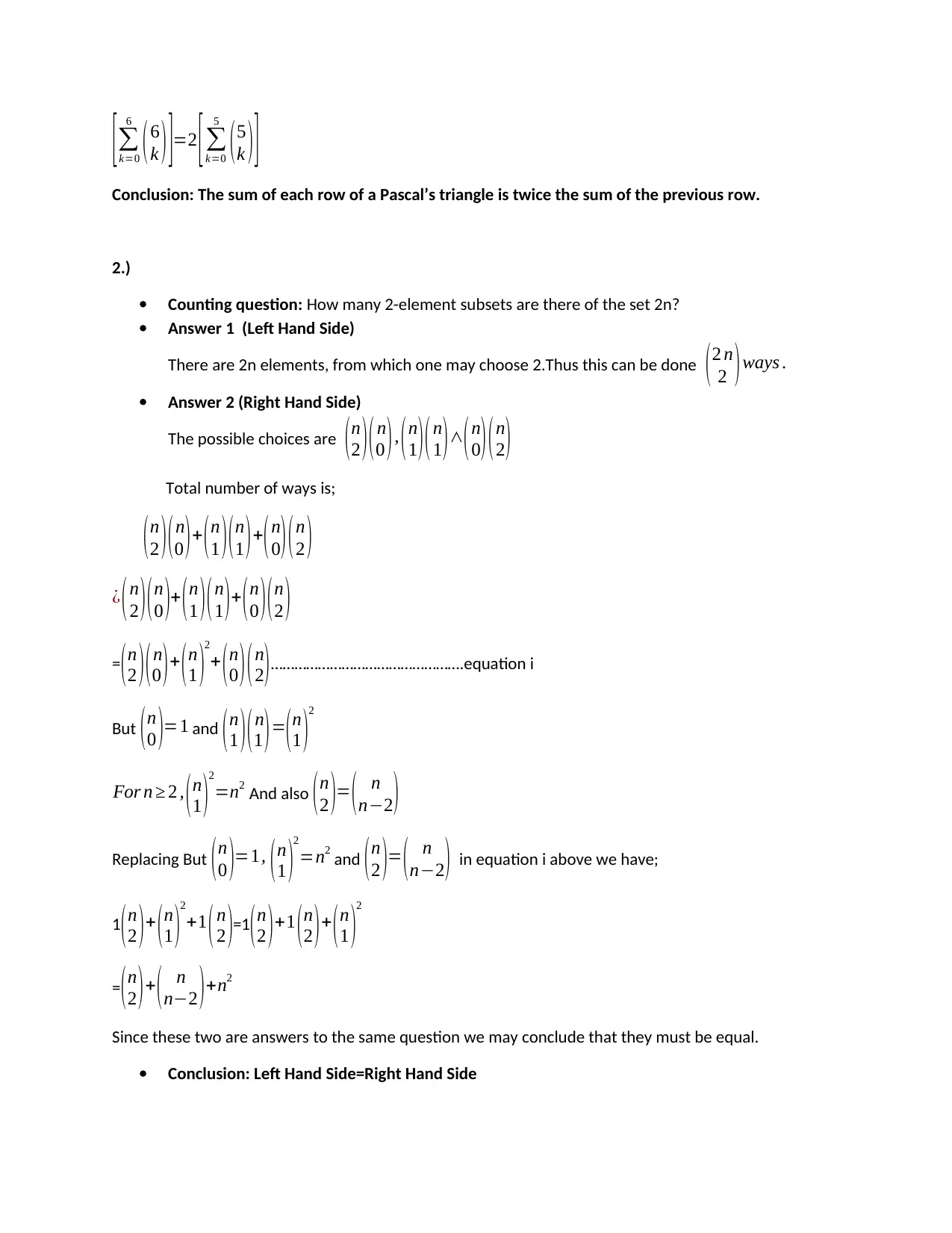
[∑
k=0
6
(6
k ) ]=2 [∑
k=0
5
(5
k ) ]
Conclusion: The sum of each row of a Pascal’s triangle is twice the sum of the previous row.
2.)
Counting question: How many 2-element subsets are there of the set 2n?
Answer 1 (Left Hand Side)
There are 2n elements, from which one may choose 2.Thus this can be done (2 n
2 )ways .
Answer 2 (Right Hand Side)
The possible choices are (n
2 )(n
0 ), (n
1 )(n
1)∧(n
0)(n
2)
Total number of ways is;
(n
2 )(n
0 )+ (n
1 )(n
1 )+
(n
0 )(n
2 )
¿ ( n
2 )( n
0 )+ ( n
1 )( n
1 ) + ( n
0 )( n
2 )
=
(n
2 )(n
0 )+ (n
1 )2
+ (n
0 )(n
2)………………………………………….equation i
But (n
0 )=1 and (n
1 )(n
1 )=
(n
1 )2
For n ≥ 2 , (n
1 )2
=n2 And also ( n
2 )= ( n
n−2)
Replacing But (n
0 )=1, ( n
1 )
2
=n2 and (n
2 )= ( n
n−2 ) in equation i above we have;
1
( n
2 ) + ( n
1 )
2
+1 ( n
2 )=1
( n
2 ) +1 ( n
2 ) + ( n
1 )
2
=( n
2 ) + ( n
n−2 ) +n2
Since these two are answers to the same question we may conclude that they must be equal.
Conclusion: Left Hand Side=Right Hand Side
k=0
6
(6
k ) ]=2 [∑
k=0
5
(5
k ) ]
Conclusion: The sum of each row of a Pascal’s triangle is twice the sum of the previous row.
2.)
Counting question: How many 2-element subsets are there of the set 2n?
Answer 1 (Left Hand Side)
There are 2n elements, from which one may choose 2.Thus this can be done (2 n
2 )ways .
Answer 2 (Right Hand Side)
The possible choices are (n
2 )(n
0 ), (n
1 )(n
1)∧(n
0)(n
2)
Total number of ways is;
(n
2 )(n
0 )+ (n
1 )(n
1 )+
(n
0 )(n
2 )
¿ ( n
2 )( n
0 )+ ( n
1 )( n
1 ) + ( n
0 )( n
2 )
=
(n
2 )(n
0 )+ (n
1 )2
+ (n
0 )(n
2)………………………………………….equation i
But (n
0 )=1 and (n
1 )(n
1 )=
(n
1 )2
For n ≥ 2 , (n
1 )2
=n2 And also ( n
2 )= ( n
n−2)
Replacing But (n
0 )=1, ( n
1 )
2
=n2 and (n
2 )= ( n
n−2 ) in equation i above we have;
1
( n
2 ) + ( n
1 )
2
+1 ( n
2 )=1
( n
2 ) +1 ( n
2 ) + ( n
1 )
2
=( n
2 ) + ( n
n−2 ) +n2
Since these two are answers to the same question we may conclude that they must be equal.
Conclusion: Left Hand Side=Right Hand Side
Paraphrase This Document
Need a fresh take? Get an instant paraphrase of this document with our AI Paraphraser
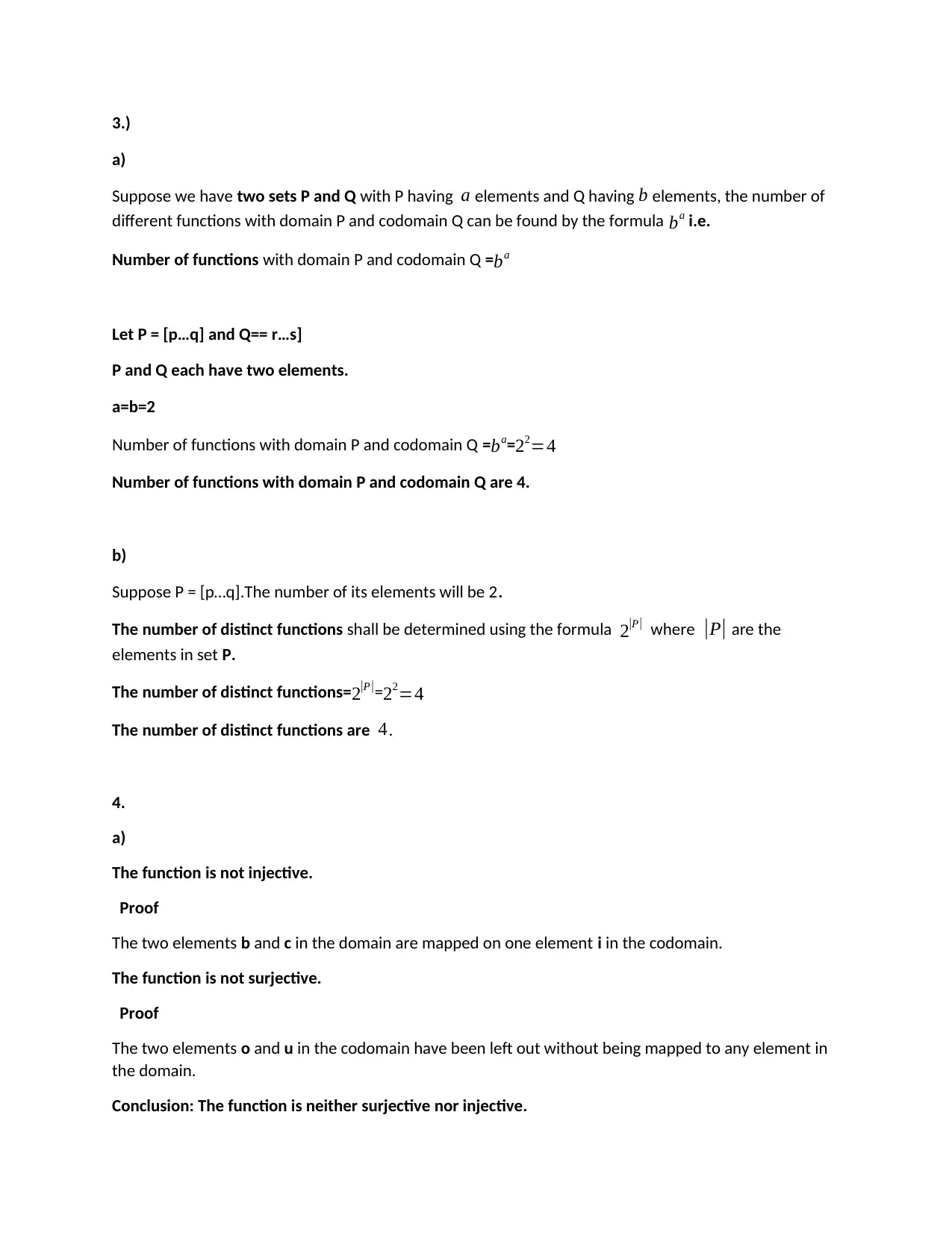
3.)
a)
Suppose we have two sets P and Q with P having a elements and Q having b elements, the number of
different functions with domain P and codomain Q can be found by the formula ba i.e.
Number of functions with domain P and codomain Q =ba
Let P = [p…q] and Q== r…s]
P and Q each have two elements.
a=b=2
Number of functions with domain P and codomain Q =ba=22=4
Number of functions with domain P and codomain Q are 4.
b)
Suppose P = [p…q].The number of its elements will be 2.
The number of distinct functions shall be determined using the formula 2|P | where |P| are the
elements in set P.
The number of distinct functions=2|P |=22=4
The number of distinct functions are 4.
4.
a)
The function is not injective.
Proof
The two elements b and c in the domain are mapped on one element i in the codomain.
The function is not surjective.
Proof
The two elements o and u in the codomain have been left out without being mapped to any element in
the domain.
Conclusion: The function is neither surjective nor injective.
a)
Suppose we have two sets P and Q with P having a elements and Q having b elements, the number of
different functions with domain P and codomain Q can be found by the formula ba i.e.
Number of functions with domain P and codomain Q =ba
Let P = [p…q] and Q== r…s]
P and Q each have two elements.
a=b=2
Number of functions with domain P and codomain Q =ba=22=4
Number of functions with domain P and codomain Q are 4.
b)
Suppose P = [p…q].The number of its elements will be 2.
The number of distinct functions shall be determined using the formula 2|P | where |P| are the
elements in set P.
The number of distinct functions=2|P |=22=4
The number of distinct functions are 4.
4.
a)
The function is not injective.
Proof
The two elements b and c in the domain are mapped on one element i in the codomain.
The function is not surjective.
Proof
The two elements o and u in the codomain have been left out without being mapped to any element in
the domain.
Conclusion: The function is neither surjective nor injective.
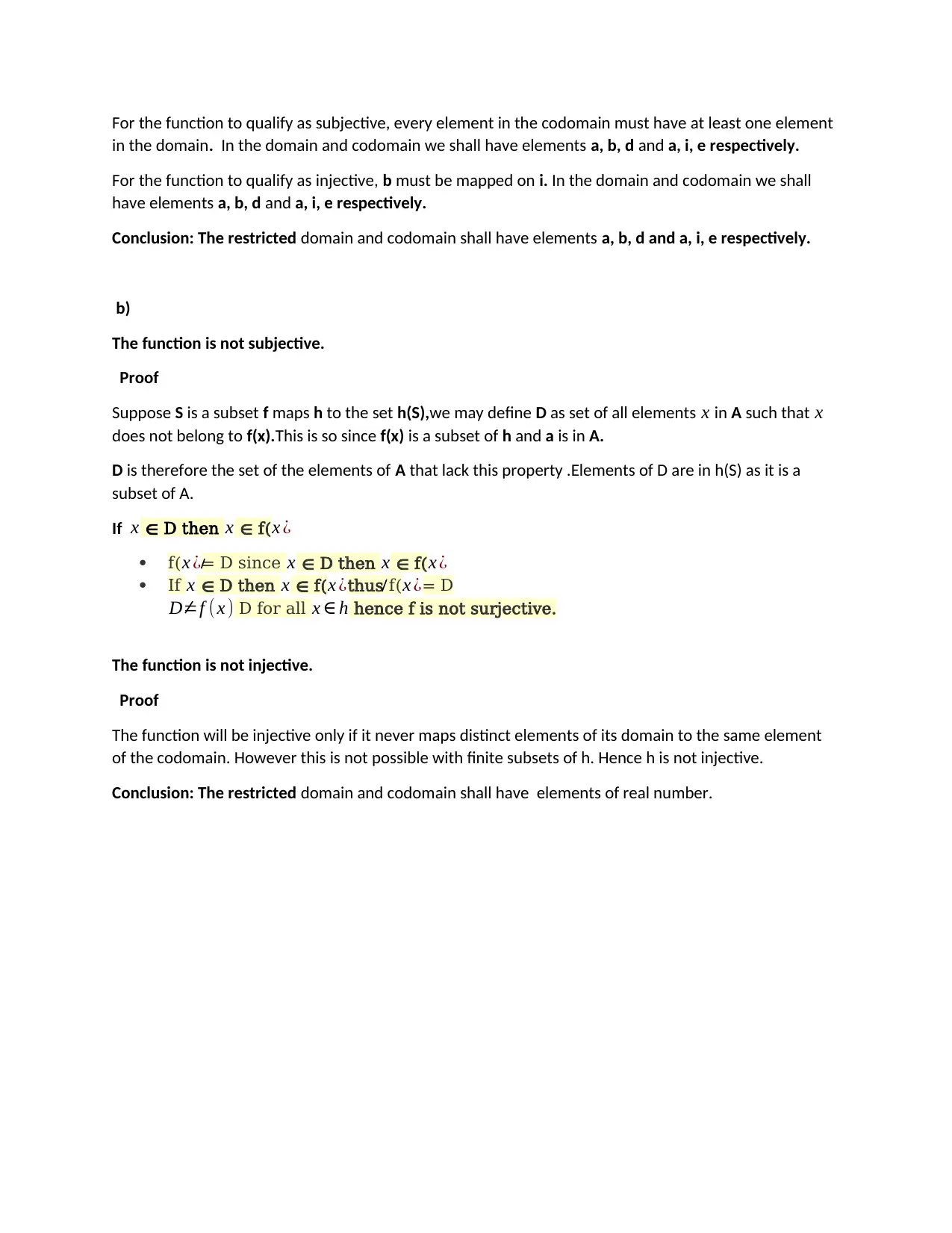
For the function to qualify as subjective, every element in the codomain must have at least one element
in the domain. In the domain and codomain we shall have elements a, b, d and a, i, e respectively.
For the function to qualify as injective, b must be mapped on i. In the domain and codomain we shall
have elements a, b, d and a, i, e respectively.
Conclusion: The restricted domain and codomain shall have elements a, b, d and a, i, e respectively.
b)
The function is not subjective.
Proof
Suppose S is a subset f maps h to the set h(S),we may define D as set of all elements x in A such that x
does not belong to f(x).This is so since f(x) is a subset of h and a is in A.
D is therefore the set of the elements of A that lack this property .Elements of D are in h(S) as it is a
subset of A.
If x ∈ D then x ∈ f(x ¿
f(x ¿= D since x ∈ D then x ∈ f(x ¿
If x ∈ D then x ∈ f( x ¿thus f( x ¿= D
D=f ( x ) D for all x ∈ h hence f is not surjective.
The function is not injective.
Proof
The function will be injective only if it never maps distinct elements of its domain to the same element
of the codomain. However this is not possible with finite subsets of h. Hence h is not injective.
Conclusion: The restricted domain and codomain shall have elements of real number.
in the domain. In the domain and codomain we shall have elements a, b, d and a, i, e respectively.
For the function to qualify as injective, b must be mapped on i. In the domain and codomain we shall
have elements a, b, d and a, i, e respectively.
Conclusion: The restricted domain and codomain shall have elements a, b, d and a, i, e respectively.
b)
The function is not subjective.
Proof
Suppose S is a subset f maps h to the set h(S),we may define D as set of all elements x in A such that x
does not belong to f(x).This is so since f(x) is a subset of h and a is in A.
D is therefore the set of the elements of A that lack this property .Elements of D are in h(S) as it is a
subset of A.
If x ∈ D then x ∈ f(x ¿
f(x ¿= D since x ∈ D then x ∈ f(x ¿
If x ∈ D then x ∈ f( x ¿thus f( x ¿= D
D=f ( x ) D for all x ∈ h hence f is not surjective.
The function is not injective.
Proof
The function will be injective only if it never maps distinct elements of its domain to the same element
of the codomain. However this is not possible with finite subsets of h. Hence h is not injective.
Conclusion: The restricted domain and codomain shall have elements of real number.
⊘ This is a preview!⊘
Do you want full access?
Subscribe today to unlock all pages.

Trusted by 1+ million students worldwide
1 out of 6
Related Documents
Your All-in-One AI-Powered Toolkit for Academic Success.
+13062052269
info@desklib.com
Available 24*7 on WhatsApp / Email
![[object Object]](/_next/static/media/star-bottom.7253800d.svg)
Unlock your academic potential
Copyright © 2020–2025 A2Z Services. All Rights Reserved. Developed and managed by ZUCOL.





